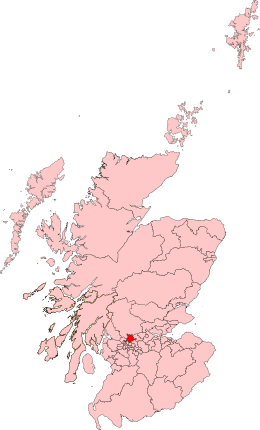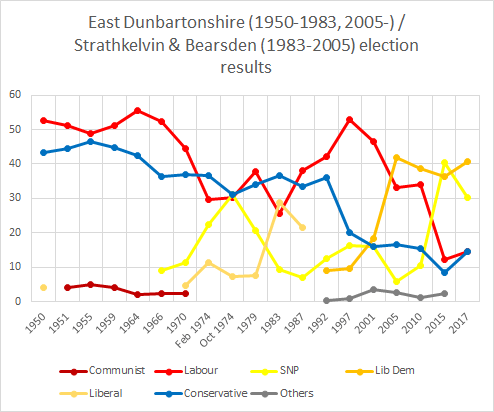Strathkelvin and Bearsden (UK Parliament constituency)
Strathkelvin and Bearsden was a parliamentary constituency represented in the House of Commons of the Parliament of the United Kingdom from 1983. In 2005, the constituency was abolished, and the area is now represented by East Dunbartonshire and Cumbernauld, Kilsyth and Kirkintilloch East.
| Strathkelvin and Bearsden | |
|---|---|
| Former County constituency for the House of Commons | |
 Boundary of Strathkelvin and Bearsden in Scotland for the 2001 general election | |
| 1983–2005 | |
| Number of members | One |
| Replaced by | East Dunbartonshire Cumbernauld, Kilsyth & Kirkintilloch East |
| Created from | East Dunbartonshire, North Lanarkshire and West Stirlingshire[1] |
The Scottish Parliament constituency of Strathkelvin and Bearsden, which covered the same area, continues in existence.
Boundaries
1983–1997: The Strathkelvin District electoral divisions of Bishopbriggs and Kirkintilloch, and the Bearsden and Milngavie District electoral divisions of Bearsden and Kilmardinny.
1997–2005: The Strathkelvin District electoral divisions of Bishopbriggs, Kirkintilloch, and Strathkelvin North, and the Bearsden and Milngavie District electoral division of Bearsden.
Members of Parliament
| Election | Member | Party | |
|---|---|---|---|
| 1983 | Michael Hirst | Conservative | |
| 1987 | Sam Galbraith | Labour | |
| 2001 | John Lyons | Labour | |
| 2005 | constituency abolished: see East Dunbartonshire & Cumbernauld, Kilsyth and Kirkintilloch East | ||
Election results

Elections of the 1980s
| Party | Candidate | Votes | % | ± | |
|---|---|---|---|---|---|
| Conservative | Michael Hirst | 17,501 | 36.5 | -10.0 | |
| Liberal | Ronald Waddell | 13,801 | 28.7 | +18.5 | |
| Labour | Adam Ingram | 12,308 | 25.6 | -4.8 | |
| SNP | Margaret Bain | 4,408 | 9.2 | -3.7 | |
| Majority | 3,700 | 7.7 | N/A | ||
| Turnout | 48,018 | 79.4 | N/A | ||
| Conservative win (new seat) | |||||
| Party | Candidate | Votes | % | ± | |
|---|---|---|---|---|---|
| Labour | Sam Galbraith | 19,639 | 38.1 | +12.5 | |
| Conservative | Michael Hirst | 17,187 | 33.4 | −3.1 | |
| Liberal | Jim Bannerman | 11,034 | 21.4 | −7.3 | |
| SNP | Gil Paterson | 3,654 | 7.1 | −2.1 | |
| Majority | 2,452 | 4.7 | |||
| Turnout | 51,514 | 82.2 | +2.8 | ||
| Labour gain from Conservative | Swing | ||||
Elections of the 1990s
| Party | Candidate | Votes | % | ± | |
|---|---|---|---|---|---|
| Labour | Sam Galbraith | 21,267 | 42.2 | +4.1 | |
| Conservative | Michael Hirst | 18,105 | 36.0 | +2.6 | |
| SNP | Thomas Chalmers | 6,275 | 12.5 | +5.4 | |
| Liberal Democrats | Barbara Waterfield | 4,585 | 9.1 | −12.3 | |
| Natural Law | David Whitley | 90 | 0.2 | N/A | |
| Majority | 3,162 | 6.2 | |||
| Turnout | 50,322 | 82.2 | +0.0 | ||
| Labour hold | Swing | −0.8 | |||
| Party | Candidate | Votes | % | ± | |
|---|---|---|---|---|---|
| Labour | Sam Galbraith | 26,278 | 52.9 | +6.8 | |
| Conservative | David Sharpe | 9,986 | 20.1 | −12.5 | |
| SNP | Graeme McCormick | 8,111 | 16.3 | +3.4 | |
| Liberal Democrats | John Morrison | 4,843 | 9.7 | +1.5 | |
| Referendum | David Wilson | 339 | 0.7 | N/A | |
| Natural Law | Christine Fisher | 155 | 0.3 | +0.1 | |
| Majority | 16,292 | 32.8 | |||
| Turnout | 49,712 | 78.8 | −4.9 | ||
| Labour hold | Swing | +4.1 | |||
Elections of the 2000s
| Party | Candidate | Votes | % | ± | |
|---|---|---|---|---|---|
| Labour | John Lyons | 19,250 | 46.4 | −6.5 | |
| Liberal Democrats | Gordon McDonald | 7,533 | 18.2 | +8.4 | |
| SNP | Calum Smith | 6,675 | 16.1 | −0.2 | |
| Conservative | William Roxburgh | 6,635 | 16.0 | −4.1 | |
| Scottish Socialist | Willie Telfer | 1,393 | 3.4 | N/A | |
| Majority | 11,717 | 28.2 | |||
| Turnout | 41,486 | 66.0 | −12.8 | ||
| Labour hold | Swing | ||||
References
- "'Strathkelvin and Bearsden', June 1983 up to May 1997". ElectionWeb Project. Cognitive Computing Limited. Archived from the original on 15 March 2016. Retrieved 14 March 2016.
- "Election Data 1983". Electoral Calculus. Archived from the original on 15 October 2011. Retrieved 28 June 2017.
- "Election Data 1987". Electoral Calculus. Archived from the original on 15 October 2011. Retrieved 28 June 2017.
- "Election Data 1992". Electoral Calculus. Archived from the original on 15 October 2011. Retrieved 28 June 2017.
- "Election Data 1997". Electoral Calculus. Archived from the original on 15 October 2011. Retrieved 28 June 2017.
- "Election Data 2001". Electoral Calculus. Archived from the original on 15 October 2011. Retrieved 28 June 2017.